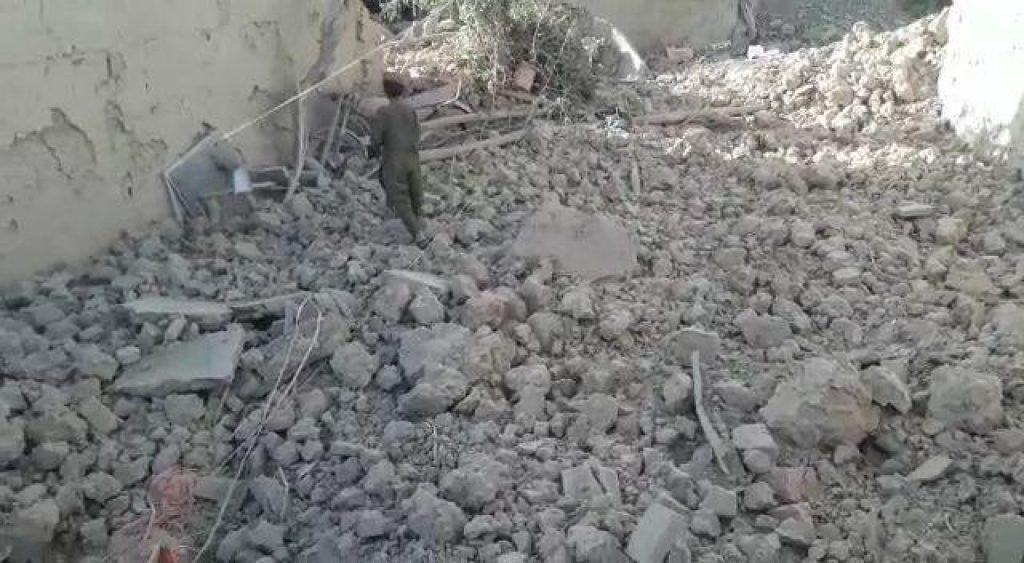
Late yesterday, U.S. and Afghan forces targeted al Qaeda members in Musa Qala, a Taliban-controlled district in Afghanistan’s southern Helmand province. The U.S. military said that “massed al Qaeda figures” at the location “presented an imminent threat.”
The Afghan government reported that “a high-profile Al Qaeda group” was “embedded with Taliban leaders” at the raid site.
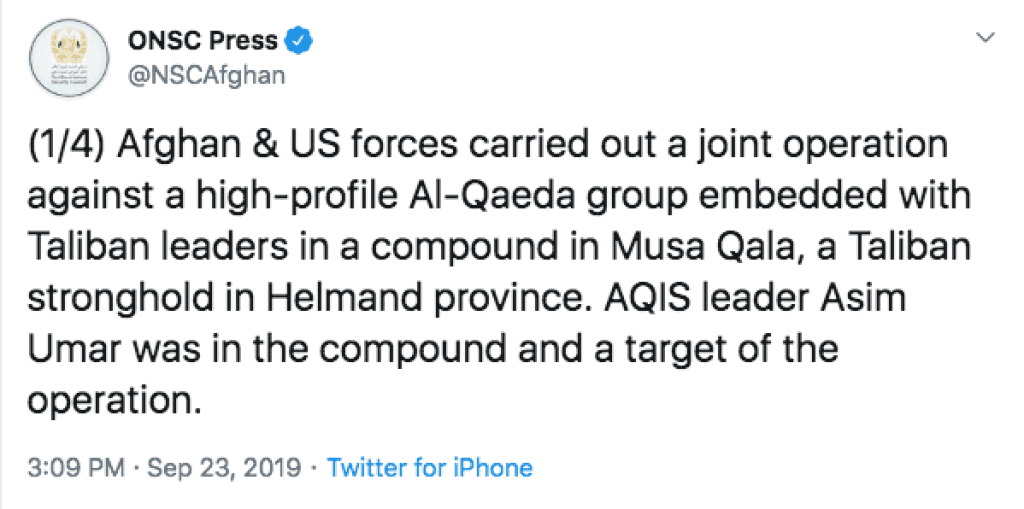
The joint operations immediately caused controversy, as some accounts indicate that dozens of civilians were killed. The precise cause of the civilian casualties, including women and children, is under investigation. Several reports say at least some of the deceased were attending a wedding party.
Airstrikes were called in as American and Afghan forces battled al Qaeda and Taliban fighters at the compound in Musa Qala.
According to U.S. military officials, the airstrikes were conducted “against barricaded terrorists firing on Afghan and U.S. forces.” The U.S. assesses that “the majority of those killed in the fighting died from al Qaeda weapons or in the explosion of the terrorists’ explosives caches or suicide vests.”
That is, the U.S. claims al Qaeda is responsible for most of the civilian casualties.
According to President Ashraf Ghani’s national security staff, the target of the raid was Asim Umar, the first leader of Al Qaeda in the Indian Subcontinent (AQIS). However, it seems that Umar was not present at the time, or escaped.
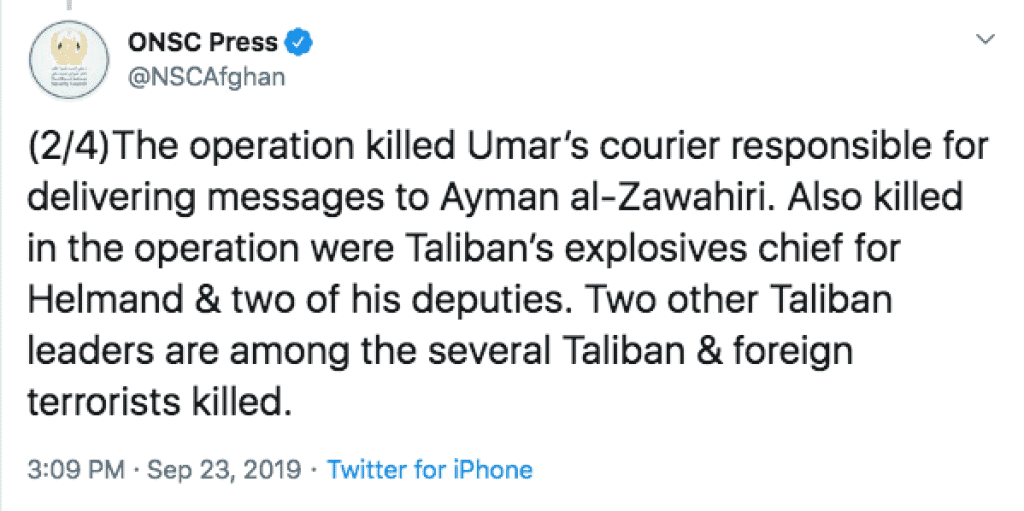
Afghanistan’s National Security Council (NSC), which reports to President Ghani, tweeted that the “joint operation” was intended to eliminate “a high-profile Al-Qaeda group embedded with Taliban leaders in a compound in Musa Qala, a Taliban stronghold in Helmand province.”
Asim Umar, the first leader of Al Qaeda in the Indian Subcontinent (AQIS), was thought to be “in the compound and a target of the operation.”
The NSC didn’t say that Umar was killed, but did claim that his “courier,” who was “responsible for delivering messages to Ayman al-Zawahiri,” met his demise.
“Also killed in the operation were Taliban’s explosives chief for Helmand & two of his deputies,” the NSC tweeted. “Two other Taliban leaders are among the several Taliban & foreign terrorists killed.”
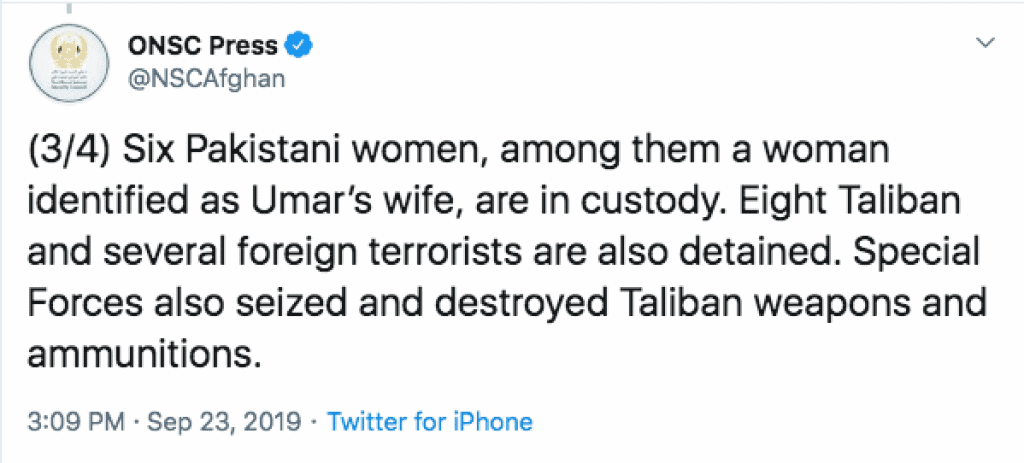
Asim Umar’s wife is among the six Pakistani women who are now in custody, according to NSC. “Eight Taliban and several foreign terrorists” were also detained, while “Taliban weapons and ammunitions” were “seized and destroyed.”
Afghan’s Ministry of Defense released a statement earlier in the day saying that “22 foreign members of Taliban were killed and 14 arrested.” Among those detained were “five Pakistani nationals and one Bangladeshi.” This “foreign terrorist group was actively engaged in organizing terrorist attacks” and “a large warehouse of the terrorists’ supplies and equipment was also demolished.”
AQIS is known to operate in both Pakistan and Bangladesh. In 2015, U.S. and Afghan forces raided two large-scale AQIS training facilities in the Shorabak district of Kandahar. General John W. Nicholson, the previous top American military commander in Afghanistan, told the Combating Terrorism Center (CTC) at West Point that intelligence and media captured during the raid showed how AQIS’s tentacles reached into Bangladesh. There “were congratulatory notes going back and forth about some of these activities in Bangladesh,” Nicholson said.
Although the Afghan government describes Asim Umar as AQIS’s overall leader, there is evidence that his one-time lieutenant is now in charge of the al Qaeda branch. Umar may have assumed another leadership role within al Qaeda. In June, Umar released a message praising the Taliban’s “victory” and America’s “defeat” in Afghanistan. He also referred to the Taliban’s overall leader, Hibatullah Akhundzada, as the “Amir-ul-Momineen,” meaning the “Emir of the Faithful.” That honorific is usually reserved for a Muslim caliph, but al Qaeda consistently uses it to describe the Taliban’s leader — an indication of his ideological importance to the movement.
[See FDD’s Long War Journal report: Senior al Qaeda official praises Taliban’s ‘victory’ in Afghanistan.]
Taliban reaction to raid in Musa Qala
The Taliban quickly produced multiple images and a video highlighting the civilian casualties in Musa Qala.
“US and Afghan forces indiscriminately raided and bombed a wedding in Kunjak & Shawaroz areas near Musa Kala bazaar, Helmand, last night during which tens of civilians mostly women and children were killed along with 6 homes and 3 vehicles destroyed,” the text in one Taliban video reads. The production is part of the jihadist group’s “Hidden Crimes” series, which highlights reports of civilian casualties caused by Afghan and Western forces.
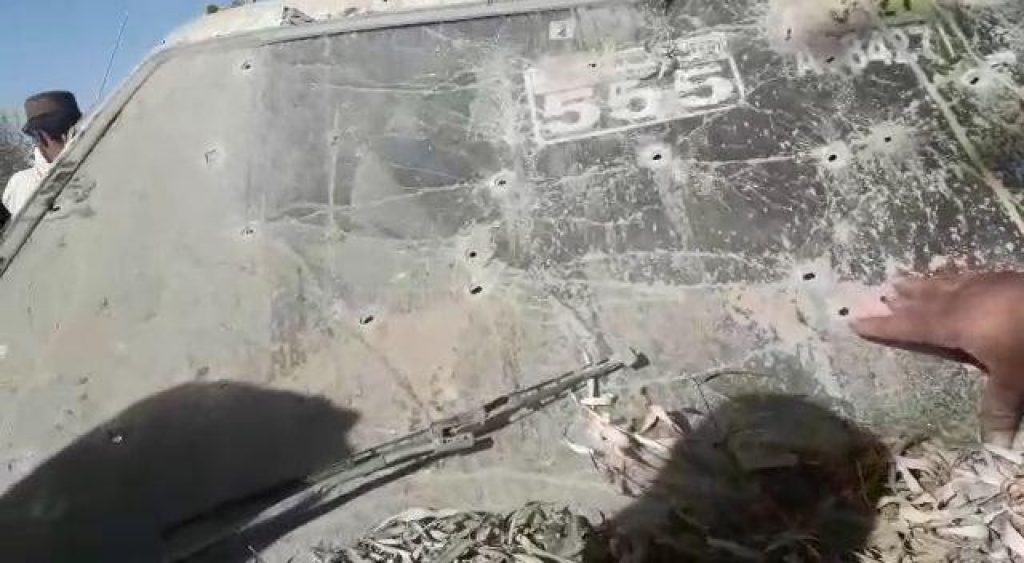
The Taliban also disseminated a series of images purportedly showing some of the children who were killed.
The Taliban hasn’t addressed al Qaeda’s reported presence at the site. But this isn’t unusual. AQIS fights under the Taliban’s banner and, with few exceptions, doesn’t advertise its direct participation in the fighting. Al Qaeda prefers to hide its hand. Moreover, the Taliban has repeatedly lied about al Qaeda’s in Afghanistan since the 1990s and only occasionally acknowledges the close relationship in public.
Until earlier this month, the State Department was prepared to endorse a deal in which the Taliban’s political office would distance their comrades from al Qaeda. While it isn’t clear what the terms of the proposed accord actually said, it was widely reported that the Taliban would renounce al Qaeda. However, there are many problems with that claim. Assuming the Afghan government and U.S. military are correct about the compound in Musa Qala, then this additional evidence showing that the Taliban and al Qaeda remain inextricably tied together. There is no evidence that the Taliban’s commanders are prepared to betray AQIS or its men.
And according to the Afghan government, the AQIS leadership is communicating directly with Ayman al-Zawahiri. That isn’t surprising, as Zawahiri and his lieutenants established AQIS in the first place.
U.S. and Afghan forces have repeatedly targeted al Qaeda, Taliban’s “Red Unit” and drug facilities in Helmand
Al Qaeda has a longstanding presence in Helmand. In Aug. 2017, for instance, Afghan forces killed several al Qaeda operatives during a raid in Helmand’s Garmsir district. Several reports indicated that AQIS had training facilities in Helmand as of 2015.
NATO and Afghan forces have repeatedly sought to damage the Taliban’s infrastructure in Musa Qala, including personnel responsible for orchestrating suicide bombings and facilities used in the group’s narcotics trafficking. In 2017, U.S. and Afghan forces struck locations throughout Helmand as part of a campaign to disrupt the Taliban’s finances.
On Nov. 21 2017, General John W. Nicholson, the commander of Resolute Support and U.S. Forces – Afghanistan at the time, explained that “new authorities” allowed the U.S. to bolster Afghan raids on Taliban drug networks and other facilities in Helmand. The “primary focus of this particular operation’s been in Northern Helmand, the so-called emirate of the Taliban, where they have enjoyed relative freedom of action for the last several years and where much of their drug enterprise is located,” Nicholson said. Among the targets was a “Taliban narcotics production facility in Musa Qala.”
On Dec. 1, 2017, a Taliban “Red Unit” commander known as Mullah Shah Wali (also known as Haji Nasir) “was killed in a kinetic strike” in Musa Qala, according to NATO’s Resolute Support. “One of Wali’s deputy commanders and three other insurgents were also killed in the strike.”
Resolute Support explained that Wali and his men were “responsible for planning numerous suicide bombings, Improvised Explosives Device (IED) attacks, and coordinated assaults against civilians, Afghan and coalition forces.” Wali “was directly responsible for coordinating operations and resupply of munitions, explosives, and materials for the Taliban throughout Helmand province.”
General Nicholson also connected Wali to the Taliban’s narcotics production and trafficking in Helmand, claiming his demise would “degrade” their drug trade.
On May 24, 2018, Task Force-Southwest, which operates under U.S. Forces-Afghanistan, conducted a “ground-based rocket artillery strike using the M142 High Mobility Artillery Rocket System, or HIMARS, against a command and control node for high-level Taliban leaders in” Musa Qala.







